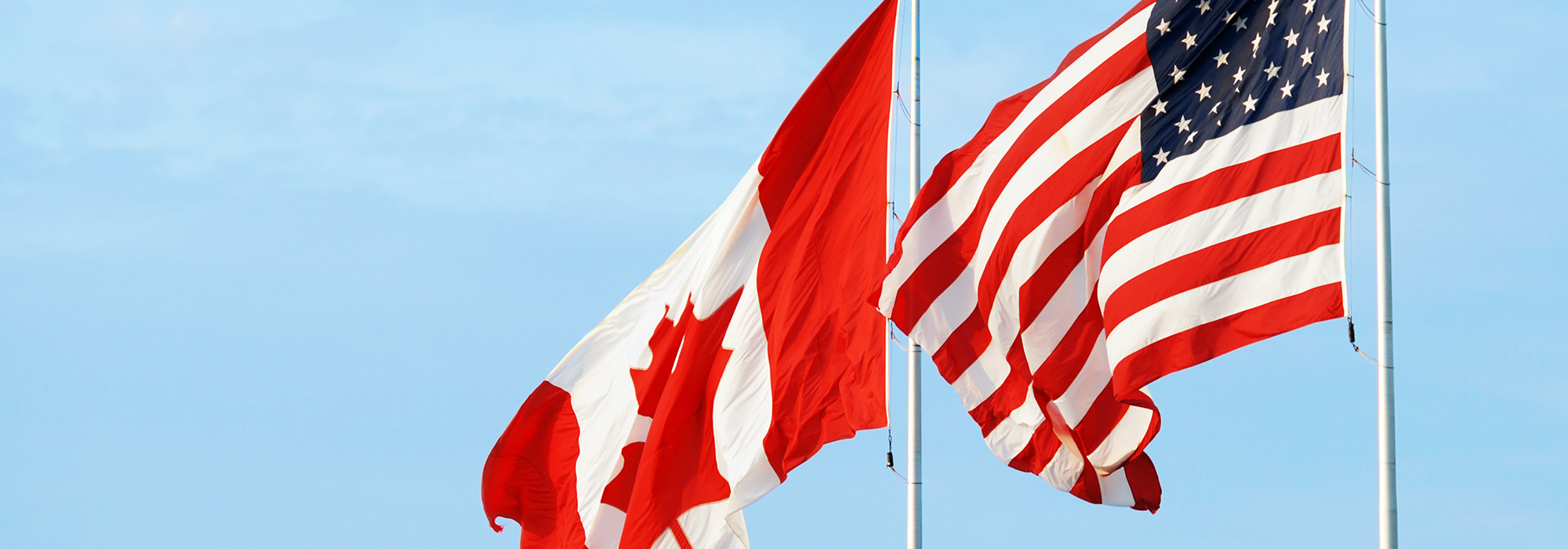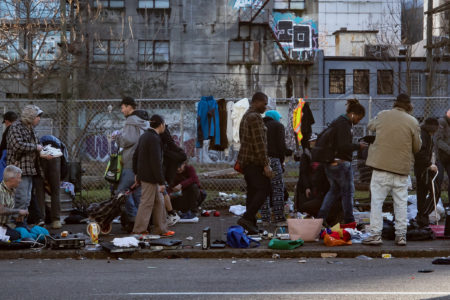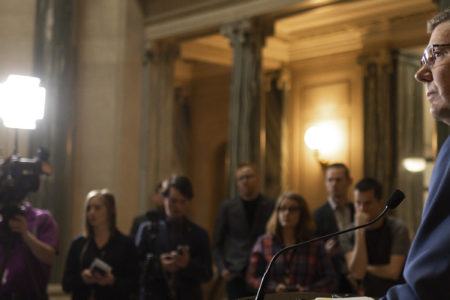
In November 2009, the Historica-Dominion Institute commissioned a poll on the first anniversary of the election of Barack Obama. It asked how Canadians felt about the United States, knowing that Obama was far more popular among Canadians in 2009 than George W. Bush was in 2005, when the institute took a similar poll. The assumption was that our fondness for the new president would warm our more general view of our neighbour.
Yet the poll found that Canadians were only slightly more favourable toward the United States than they had been four years earlier. Obama’s election had not eroded a distrust of the United States in Canada. Indeed, Canadians had detached their personal view of Obama, whom they like and respect, from the United States, which they still view with skepticism and reserve.
When asked if they “feel at home” when they visit the United States, for example, only 48 percent of Canadians agreed. Four years before, only 44 percent agreed. Canadians were also divided on whether the United States is “a force for good in the world.” While 44 percent agreed, 46 percent disagreed.
It is important to know that whether George W. Bush or Barack Obama is president, Canadians like Americans as individuals. But we don’t feel at home among them, as if they are foreign, and we doubt the American view of the world, as if their values and ambitions are antithetical to ours.
There are reasons that we don’t feel comfortable in the US, much as we visit, study and work there. After all, there is much that is different between it and us. Our differences are the thesis of Fire and Ice: The United States, Canada and the Myth of Converging Values, a provocative book published in 2003 by pollster Michael Adams. He argues that, in many ways, Canadians and Americans are diverging. Not for him the old, soothing orthodoxy that the border is an artificial separation of two peoples of similar instinct, imagination and ideals. His view, based on surveys done in the 1990s, is that we are actually drifting apart.
But what is striking today, in a number of ways, is how we are becoming more like them. Indeed, there is reason to suggest that our characters are converging. We are similar and becoming more so, particularly in how we live, how we think and how we act. Some of this is on account of how we have changed. Some is on account of how the Americans have changed.
Consider four enduring assumptions about the Americans and us that are no longer true.
First, obesity. There was a time we Canadians thought we were skinny and they were fat. We laughed at the caricature of the American who couldn’t fit into the airplane seat beside us because, well, he needed two seats. The American was overweight because food was cheap, appetites were large, portions were huge and gratification was encouraged. No wonder, we noted, that Starbucks recently introduced the trenta, a gargantuan cup for its cold drinks some two and one-half times the size of the average can of pop. If everything isn’t better in America, everything is bigger in America.
Being skinny, shorthand for being fit, flattered our superior sense of wellbeing. If that was ever true, it isn’t anymore. Obesity is an epidemic in Canada, particularly among children. Our obesity levels are not as high as those in the United States, but they are catching up. We were the fifth most overweight or obese nation in the world; the United States is the first. Sixty percent of us are overweight or obese; in the United States, it is about two-thirds.
It isn’t surprising that obesity is entering the popular consciousness in Canada. As the Ottawa Citizen editorialized: “It is becoming harder and harder to be self-righteous and denigrate the Americans for their supersized lifestyle — a lifestyle we evidently share.”
Second, frugality. There was a time Canadians believed that we were savers and they were spenders. Put differently, we were restrained with money; they were extravagant. We saved, they spent. We were misers, they were spendthrifts.
Our inclination to spend is why the federal government has moved twice in the last year to toughen the rules on mortgages. Clearly it’s worrying about our exposure. It knows that when interest rates rise, as they surely will, many Canadian homeowners will be unable to sustain their mortgages.
To a degree, some of that is true today. The reason our banks are called the safest in the world is that they are conservative in lending money. It is harder to buy a house here and becoming more so. We cannot deduct the interest on our mortgage from our income tax and we do not have as generous terms. It is one of the reasons we don’t have high rates of foreclosure. So, we’re frugal, right?
Not really. Mark Carney, the Governor of the Bank of Canada, warns of our rising household debt: “The greater the complacency, the more brutal the reckoning.” He joins the Minister of Finance and others who tell us constantly that we are living beyond our means. It seems that we, too, want all those things of the great consumer society — big-screen televisions, SUVs, winter vacations — and we want them on borrowed money. At the end of 2009, our household debt was a record
$1.41 trillion, some $96,000 per household. Our debt-to-asset ratio is the highest in the OECD, and Canada’s debt-to-income ratio reached a record high in the third quarter of 2010 of 148.1 percent.
We have heard much about the perils of American debt, and in terms of government (national debt and budgetary deficit), ours is far healthier than that of the Americans or Europeans. But while it may be comforting to think of ourselves as more virtuous, it isn’t consistently so. We are not saving as we once did. In 2004, our personal savings rate fell below zero for the first time since Ottawa began collecting figures in 1961. Moreover, our savings rate fell below that of the United States. Our inclination to spend is why the federal government has moved twice in the last year to toughen the rules on mortgages. Clearly it’s worrying about our exposure. It knows that when interest rates rise, as they surely will, many Canadian homeowners will be unable to sustain their mortgages. Canada will face its own foreclosure crisis, the “reckoning” that Carney fears.
There is also a growing convergence on income distribution. We have long thought ourselves a more equitable country, which redistributes wealth through higher taxes and generous social programs. In the US, 1 percent of the population controls about 25 percent of national income, a figure that has tripled since 1978. In Canada, a kinder, gentler place, the top 1 percent controls 17 percent of national income, a figure that has doubled. The gap isn’t as wide as we might think.
Third, crime. Another of our boasts in Canada is low crime. By and large, this is also true (though if you believe the Conservatives in Ottawa, it isn’t true, which is why they are building prisons). And though it may be hard to believe, it is also true of the US. While many of us still think that American cities are combat zones, it’s no longer so. The rate of violent crime in American cities is dropping to levels unseen since the 1960s. Our image of the embattled American cowering behind locked doors no longer holds.
In dealing with violent crime, one of the biggest changes in the US is its growing aversion to capital punishment. Some states have abolished the death penalty, some have stopped using it. All told, there are half as many executions today as 10 years ago. The use of the death penalty fell 12 percent last year; only 12 of 53 jurisdictions carried out executions. Fifteen of 50 states don’t have the death penalty; earlier this year, Illinois moved to abolish capital punishment. California, a state with more people than Canada, has not had an execution in five years. In November, it elected a governor and an attorney general who oppose the death penalty. In the United States as a whole, the rate of executions today is the lowest since the death penalty was restored in 1976.
In Texas, which has used the death penalty more than anywhere else, they were executing 40 people a year in 2000. Last year, it was 17, 29 percent fewer than the year before. It reflects an America retreating from capital punishment, as Canada did in 1976. The United States now ranks 24th in the world in murders per capita; Canada ranks 44th.
Fourth, ethnicity. In Canada, we see ourselves as a mosaic. Immigrants come here and remain free to be who they are, without pressure to conform. We are proud of this (even if it leads to a balkanized country). We see the US as a melting pot. Immigrants adopt the norms, values, traditions and cultures of the majority. We like to think we offer newcomers independence, while Americans demand uniformity. If that was so, it no longer is.
Consider Hispanic America. So distinct is the Spanish community in the United States that increasingly Spanish is becoming to America what French is to Canada. In 2009, there were 48.4 million Hispanic Americans, 16 percent of the population. They are now the country’s largest, fastest-growing minority. Thirty-five million people over five years old speak Spanish at home. Half are said to speak English very well, which suggests the other half do not, hindering assimilation. It is projected there will be 132 million Hispanic Americans by 2050, representing a third of the population. If this is a melting pot, where immigrants jump in on arrival and emerge red-blooded Americans, it isn’t looking like a pot, and it isn’t melting.
As we have unassimilated newcomers, so do they; the rates of integration are about the same on both sides of the border. As critics here question multiculturalism, they do in the US, too. In 1992, Arthur Schlesinger, the celebrated liberal historian, raised the alarm in his book The Disuniting of America: Reflections on a Multicultural Society. He lamented “identity politics” and the rise of ethnic interests, undermining the civic virtues that have kept the nation together. Sound familiar? It’s a debate you might hear in Canada.
These, then, are ways in which our peoples are more alike than we thought. We Canadians have become bigger in appearance and more profligate with money. The Americans are safer in their cities, as we are, and more Hispanic in their composition, just as for so long French Canada defined what we were. Americans are using capital punishment significantly less. Collectively, it makes for two peoples less different than many in Canada would imagine — or admit.
On other social touchstone issues — homosexuality, divorce, abortion — Canada remains more progressive. But here, too, the United States is changing. The Defence of Marriage Act of 1996, which defines marriage as a union between a man and a woman, is being challenged in court. Gay marriage is legal in a few states and illegal in most. Divorce is now nofault in all 50 states. Abortion remains contentious, but it is here, too. Just as a woman cannot get an abortion in places in the US, there are jurisdictions where she cannot in Canada, either.
In political practice, there is also a curious convergence between our two countries. In Canada, eight provinces and territories — and the federal government — have fixed election dates.
Fifteen of 50 states don’t have the death penalty; earlier this year, Illinois moved to abolish capital punishment. California, a state with more people than Canada, has not had an execution in five years. In November, it elected a governor and an attorney general who oppose the death penalty. In the United States as a whole, the rate of executions today is the lowest since the death penalty was restored in 1976.
In the Senate, the government remains committed to an elected body, like the United States Senate. This government has also introduced parliamentary review of its appointments to the Supreme Court, which doesn’t mean much, really, but resembles the process in the United States, where senior presidential appointees must be approved by the Senate. One of our provinces, British Columbia, has embraced petition and recall, like some American states. All these might be considered American ideas.
The most American idea in our country, of course, is the Charter of Rights and Freedoms. Its critics say we have imported a foreign practice and grafted it onto our parliamentary system. Maybe so, but Canadians are now aggressively asserting their rights, making Canada a more litigious society in which the courts are ascendant. The Charter has become a touchstone of our identity, polls show.
Another convergence: While our discourse has not degenerated into the acrimonious wail it has in America, the conversation has certainly coarsened in Canada. The rancour of Question Period shows why there is a move among parliamentarians to restore civility to the House of Commons. As we have a more contentious politics, we now have attack ads that the Conservatives, in particular, have used effectively on Stéphane Dion and Michael Ignatieff. In the same way, with the same take-no-prisoners intensity, Stephen Harper continues to portray coalition government as unconstitutional, unCanadian and unseemly. It reflects a political discourse characterized by sophistry, falsehood and drive-by smear. Interestingly, both the Bloc Québécois and the Liberals attribute the Conservative attack ads to the Republicans, accusing the Conservatives of importing American scorched-earth politics.
This is where we, in Canada, have gone. But what about the Americans? For years, if you asked a Canadian the biggest difference between us and the US, the answer would be health care. We were proud of our public health care, which we introduced in the 1960s. In North America, it was ours alone. It gave us bragging rights, a monopoly on empathy.
Now the United States has adopted a form of health care. It isn’t our system of mandatory coverage and universal access, or that of the Europeans. But it will extend coverage to many who do not have it. It is a first step. And yes, it was and is highly contentious in the US. The Democrats may well have lost the House of Representatives, and nearly the Senate, because of it. The town hall meetings in the summer of 2009 were acrimonious, and Canada was often the whipping boy. Indeed, as “American-style” has become a default term for nationalists and antiAmericans to describe anything bad from the south, so now “Canadianstyle” is an epithet when used in attacking health care reform in the US.
So here we see an evolution. In Canada we become more like Americans in how we look, spend and act. Meanwhile, we adopt some of their political practices, such as attack ads and fixed election dates. Call this the Americanization of Canada.
In the US, they become like us in the growth of government, the intervention of the state in support of the big automakers and, most pointedly, the adoption of the health care bill, demonized by its opponents as “Obamacare.” Call this the Canadianization of America.
This isn’t to deny real differences between Canadians and Americans. We do not have a history of violence. We do not have a gun culture. We do not kill our leaders. Religion does not have the same resonance in Canada. Our media are less politicized.
There are, though, more and more shadings of America in Canada. We don’t have a gun culture, but we do have gun violence, whether it was the massacre at the Université de Montréal’s École Polytechnique or the murder of Mounties in Alberta. It can happen here, as can social unrest, such as riots in the streets of Montreal or Calgary after hockey games.
Our media are not as divisive as the American media are, but critics fear that “Fox News North” is coming to Canada with Sun TV. Our politics has yet to produce a Sarah Palin, but we are not impervious to populists. Toronto, the largest city in Canada, has elected Rob Ford.
Differences exist, yes, but they are not as sharp and distinct as we think or, perhaps, desire. They are, in that telling phrase, “the narcissism of small differences,” which a smaller people like us finds to differentiate ourselves from a bigger people like them. It is hard for us to accept that we are becoming more alike, particularly in light of convulsive events like the shootings in Tucson. To be too similar is to reinforce doubts about our identity.
After all, if we’re not American, who are we? What happens when they come to look more like us, and we like them? Where does that leave us? We already know — we have long known — that we share a belief in democracy, freedom and human rights, the market economy and the uses of government (their New Deal, our Just Society). We favour honest government and have had it, regardless of the party in power. We believe in immigration and pluralism, unlike much of Europe. We believe in peace and security.
All those are fundamental. But take away differences over health care or multiculturalism, and other cherished touchstones of identity, and what’s left for us, and between us? Hockey? Peacekeeping? Winter?
For those who continue to define this country only in counter-distinction to the US, our converging characters are a problem. Our changing attitudes, preferences, inclinations and habits of mind are enough to create an existential crisis. We have medicare, therefore we are. But what happens, then, when their system looks like ours, which it may one day (as we embrace more private care), and suddenly we lose our corner on compassion in this neighbourhood?
Yet we need not worry unduly about where our emerging, converging, continental characters will lead. Just as free trade did not mean the end of our national identity, neither will any other economic or political configuration we may yet create in North America. Whether it is a customs union, a security perimeter, a single currency or a supranational legislature, we in Canada can know that such an arrangement will enhance our nationhood, not threaten it.
We have grown up. Our sovereignty is not only economic, political and territorial. It is now the sovereignty of identity. We are Canadians, with a distinct sense of self, and after 144 years of nationhood, let us hope that means something more than not being Americans.
Photo: Shutterstock
This article is an adaptation of the 2010-2011 McGill University J.R. Mallory Lecture in Canadian Studies, given on January 18, 2011.







